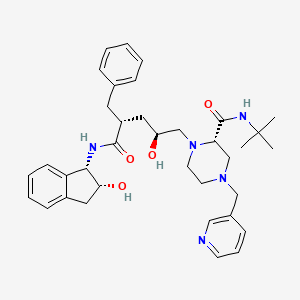
Indinavir
Descripción general
Descripción
Indinavir, conocido por su nombre comercial Crixivan, es un inhibidor de la proteasa utilizado como componente de la terapia antirretroviral de alta actividad para tratar el VIH/SIDA . Es un polvo blanco, soluble, que se administra por vía oral en combinación con otros fármacos antivirales. This compound fue producido sintéticamente para inhibir la enzima proteasa del virus VIH, evitando que el virus se reproduzca y, por lo tanto, reduciendo la carga viral en los pacientes .
Aplicaciones Científicas De Investigación
Indinavir tiene una amplia gama de aplicaciones de investigación científica, entre ellas:
Química: this compound se utiliza como un compuesto modelo en estudios de inhibidores de proteasas y sus interacciones con las enzimas.
Biología: Se utiliza para estudiar los mecanismos de replicación viral y el papel de las proteasas en los ciclos de vida viral.
Medicina: this compound es un componente fundamental de la terapia antirretroviral para el VIH/SIDA, ayudando a controlar la enfermedad y mejorar los resultados de los pacientes.
Mecanismo De Acción
Indinavir inhibe la enzima proteasa viral del VIH, que es esencial para la escisión proteolítica de los precursores de poliproteínas virales en proteínas funcionales individuales. Al unirse al sitio activo de la proteasa, this compound evita la escisión de estas poliproteínas, lo que da como resultado la formación de partículas virales inmaduras y no infecciosas. Esta inhibición reduce la carga viral en los pacientes y ralentiza la progresión del VIH/SIDA .
Compuestos Similares:
- Ritonavir
- Saquinavir
- Nelfinavir
- Lopinavir
Comparación: this compound es único entre los inhibidores de proteasas debido a su afinidad de unión específica y su mecanismo de inhibición. Si bien otros inhibidores de proteasas como el ritonavir y el saquinavir también se dirigen a la enzima proteasa del VIH, la estructura molecular de this compound permite interacciones distintas con el sitio activo de la enzima, lo que lleva a diferentes perfiles farmacocinéticos y farmacodinámicos. Además, la solubilidad y la biodisponibilidad de this compound se mejoran mediante sus modificaciones químicas específicas .
Las propiedades únicas de this compound lo convierten en una herramienta valiosa en el tratamiento del VIH/SIDA, a pesar de sus efectos secundarios y el desarrollo de resistencia en algunos casos. Su comparación con otros inhibidores de proteasas pone de manifiesto la importancia de la diversidad estructural en el desarrollo de terapias antirretrovirales efectivas .
Análisis Bioquímico
Biochemical Properties
Indinavir interacts with HIV-1 protease, an enzyme required for the proteolytic cleavage of the viral polyprotein precursors into the individual functional proteins found in infectious HIV-1 . The interaction between this compound and HIV-1 protease inhibits the activity of the enzyme .
Cellular Effects
This compound influences cell function by preventing the cleavage of the viral polyproteins, resulting in the formation of immature non-infectious viral particles . This impacts cell signaling pathways, gene expression, and cellular metabolism.
Molecular Mechanism
This compound exerts its effects at the molecular level by binding to the protease active site, inhibiting the enzyme’s activity . This inhibition prevents the cleavage of the viral polyproteins, leading to the formation of immature non-infectious viral particles .
Temporal Effects in Laboratory Settings
It is known that this compound is a potent and specific HIV protease inhibitor .
Metabolic Pathways
This compound is metabolized in the body, with seven metabolites identified, one glucuronide conjugate and six oxidative metabolites . Cytochrome P-450 3A4 (CYP3A4) is the major enzyme responsible for the formation of these oxidative metabolites .
Métodos De Preparación
Rutas Sintéticas y Condiciones de Reacción: Indinavir se sintetiza mediante un proceso de múltiples pasos que implica la formación de varios intermediariosLas condiciones de reacción generalmente implican el uso de solventes orgánicos, catalizadores y temperaturas controladas para garantizar que las transformaciones químicas deseadas ocurran de manera eficiente .
Métodos de Producción Industrial: La producción industrial de this compound implica la síntesis a gran escala utilizando condiciones de reacción optimizadas para maximizar el rendimiento y la pureza. El proceso incluye pasos de purificación rigurosos, como la cristalización y la cromatografía, para obtener el producto final en su forma pura. La producción se lleva a cabo bajo medidas estrictas de control de calidad para garantizar la consistencia y la seguridad .
Análisis De Reacciones Químicas
Tipos de Reacciones: Indinavir experimenta diversas reacciones químicas, entre ellas:
Oxidación: this compound se puede oxidar en condiciones específicas, lo que lleva a la formación de derivados oxidados.
Reducción: Las reacciones de reducción pueden modificar los grupos funcionales dentro de this compound, lo que podría alterar su actividad.
Reactivos y Condiciones Comunes:
Oxidación: Los agentes oxidantes comunes incluyen peróxido de hidrógeno y permanganato de potasio.
Reducción: Se utilizan agentes reductores como borohidruro de sodio e hidruro de aluminio y litio.
Principales Productos Formados: Los principales productos formados a partir de estas reacciones dependen de los reactivos y las condiciones específicas utilizadas. Por ejemplo, la oxidación puede llevar a la formación de derivados hidroxilados o cetónicos, mientras que la reducción puede producir alcoholes o aminas .
Comparación Con Compuestos Similares
- Ritonavir
- Saquinavir
- Nelfinavir
- Lopinavir
Comparison: Indinavir is unique among protease inhibitors due to its specific binding affinity and inhibition mechanism. While other protease inhibitors like ritonavir and saquinavir also target the HIV protease enzyme, this compound’s molecular structure allows for distinct interactions with the enzyme’s active site, leading to different pharmacokinetic and pharmacodynamic profiles. Additionally, this compound’s solubility and bioavailability are enhanced by its specific chemical modifications .
This compound’s unique properties make it a valuable tool in the treatment of HIV/AIDS, despite its side effects and the development of resistance in some cases. Its comparison with other protease inhibitors highlights the importance of structural diversity in developing effective antiretroviral therapies .
Propiedades
IUPAC Name |
(2S)-1-[(2S,4R)-4-benzyl-2-hydroxy-5-[[(1S,2R)-2-hydroxy-2,3-dihydro-1H-inden-1-yl]amino]-5-oxopentyl]-N-tert-butyl-4-(pyridin-3-ylmethyl)piperazine-2-carboxamide | |
|---|---|---|
| Source | PubChem | |
| URL | https://pubchem.ncbi.nlm.nih.gov | |
| Description | Data deposited in or computed by PubChem | |
InChI |
InChI=1S/C36H47N5O4/c1-36(2,3)39-35(45)31-24-40(22-26-12-9-15-37-21-26)16-17-41(31)23-29(42)19-28(18-25-10-5-4-6-11-25)34(44)38-33-30-14-8-7-13-27(30)20-32(33)43/h4-15,21,28-29,31-33,42-43H,16-20,22-24H2,1-3H3,(H,38,44)(H,39,45)/t28-,29+,31+,32-,33+/m1/s1 | |
| Source | PubChem | |
| URL | https://pubchem.ncbi.nlm.nih.gov | |
| Description | Data deposited in or computed by PubChem | |
InChI Key |
CBVCZFGXHXORBI-PXQQMZJSSA-N | |
| Source | PubChem | |
| URL | https://pubchem.ncbi.nlm.nih.gov | |
| Description | Data deposited in or computed by PubChem | |
Canonical SMILES |
CC(C)(C)NC(=O)C1CN(CCN1CC(CC(CC2=CC=CC=C2)C(=O)NC3C(CC4=CC=CC=C34)O)O)CC5=CN=CC=C5 | |
| Source | PubChem | |
| URL | https://pubchem.ncbi.nlm.nih.gov | |
| Description | Data deposited in or computed by PubChem | |
Isomeric SMILES |
CC(C)(C)NC(=O)[C@@H]1CN(CCN1C[C@H](C[C@@H](CC2=CC=CC=C2)C(=O)N[C@@H]3[C@@H](CC4=CC=CC=C34)O)O)CC5=CN=CC=C5 | |
| Source | PubChem | |
| URL | https://pubchem.ncbi.nlm.nih.gov | |
| Description | Data deposited in or computed by PubChem | |
Molecular Formula |
C36H47N5O4 | |
| Source | PubChem | |
| URL | https://pubchem.ncbi.nlm.nih.gov | |
| Description | Data deposited in or computed by PubChem | |
Related CAS |
157810-81-6 (sulfate (1:1) (salt)) | |
| Record name | Indinavir [USAN:INN:BAN] | |
| Source | ChemIDplus | |
| URL | https://pubchem.ncbi.nlm.nih.gov/substance/?source=chemidplus&sourceid=0150378179 | |
| Description | ChemIDplus is a free, web search system that provides access to the structure and nomenclature authority files used for the identification of chemical substances cited in National Library of Medicine (NLM) databases, including the TOXNET system. | |
DSSTOX Substance ID |
DTXSID4043802 | |
| Record name | Indinavir | |
| Source | EPA DSSTox | |
| URL | https://comptox.epa.gov/dashboard/DTXSID4043802 | |
| Description | DSSTox provides a high quality public chemistry resource for supporting improved predictive toxicology. | |
Molecular Weight |
613.8 g/mol | |
| Source | PubChem | |
| URL | https://pubchem.ncbi.nlm.nih.gov | |
| Description | Data deposited in or computed by PubChem | |
Physical Description |
Solid | |
| Record name | Indinavir | |
| Source | Human Metabolome Database (HMDB) | |
| URL | http://www.hmdb.ca/metabolites/HMDB0014369 | |
| Description | The Human Metabolome Database (HMDB) is a freely available electronic database containing detailed information about small molecule metabolites found in the human body. | |
| Explanation | HMDB is offered to the public as a freely available resource. Use and re-distribution of the data, in whole or in part, for commercial purposes requires explicit permission of the authors and explicit acknowledgment of the source material (HMDB) and the original publication (see the HMDB citing page). We ask that users who download significant portions of the database cite the HMDB paper in any resulting publications. | |
Solubility |
4.82e-02 g/L | |
| Record name | Indinavir | |
| Source | DrugBank | |
| URL | https://www.drugbank.ca/drugs/DB00224 | |
| Description | The DrugBank database is a unique bioinformatics and cheminformatics resource that combines detailed drug (i.e. chemical, pharmacological and pharmaceutical) data with comprehensive drug target (i.e. sequence, structure, and pathway) information. | |
| Explanation | Creative Common's Attribution-NonCommercial 4.0 International License (http://creativecommons.org/licenses/by-nc/4.0/legalcode) | |
| Record name | Indinavir | |
| Source | Human Metabolome Database (HMDB) | |
| URL | http://www.hmdb.ca/metabolites/HMDB0014369 | |
| Description | The Human Metabolome Database (HMDB) is a freely available electronic database containing detailed information about small molecule metabolites found in the human body. | |
| Explanation | HMDB is offered to the public as a freely available resource. Use and re-distribution of the data, in whole or in part, for commercial purposes requires explicit permission of the authors and explicit acknowledgment of the source material (HMDB) and the original publication (see the HMDB citing page). We ask that users who download significant portions of the database cite the HMDB paper in any resulting publications. | |
Mechanism of Action |
Indinavir inhibits the HIV viral protease enzyme which prevents cleavage of the gag-pol polyprotein, resulting in noninfectious, immature viral particles. | |
| Record name | Indinavir | |
| Source | DrugBank | |
| URL | https://www.drugbank.ca/drugs/DB00224 | |
| Description | The DrugBank database is a unique bioinformatics and cheminformatics resource that combines detailed drug (i.e. chemical, pharmacological and pharmaceutical) data with comprehensive drug target (i.e. sequence, structure, and pathway) information. | |
| Explanation | Creative Common's Attribution-NonCommercial 4.0 International License (http://creativecommons.org/licenses/by-nc/4.0/legalcode) | |
CAS No. |
150378-17-9 | |
| Record name | Indinavir | |
| Source | CAS Common Chemistry | |
| URL | https://commonchemistry.cas.org/detail?cas_rn=150378-17-9 | |
| Description | CAS Common Chemistry is an open community resource for accessing chemical information. Nearly 500,000 chemical substances from CAS REGISTRY cover areas of community interest, including common and frequently regulated chemicals, and those relevant to high school and undergraduate chemistry classes. This chemical information, curated by our expert scientists, is provided in alignment with our mission as a division of the American Chemical Society. | |
| Explanation | The data from CAS Common Chemistry is provided under a CC-BY-NC 4.0 license, unless otherwise stated. | |
| Record name | Indinavir [USAN:INN:BAN] | |
| Source | ChemIDplus | |
| URL | https://pubchem.ncbi.nlm.nih.gov/substance/?source=chemidplus&sourceid=0150378179 | |
| Description | ChemIDplus is a free, web search system that provides access to the structure and nomenclature authority files used for the identification of chemical substances cited in National Library of Medicine (NLM) databases, including the TOXNET system. | |
| Record name | Indinavir | |
| Source | DrugBank | |
| URL | https://www.drugbank.ca/drugs/DB00224 | |
| Description | The DrugBank database is a unique bioinformatics and cheminformatics resource that combines detailed drug (i.e. chemical, pharmacological and pharmaceutical) data with comprehensive drug target (i.e. sequence, structure, and pathway) information. | |
| Explanation | Creative Common's Attribution-NonCommercial 4.0 International License (http://creativecommons.org/licenses/by-nc/4.0/legalcode) | |
| Record name | Indinavir | |
| Source | EPA DSSTox | |
| URL | https://comptox.epa.gov/dashboard/DTXSID4043802 | |
| Description | DSSTox provides a high quality public chemistry resource for supporting improved predictive toxicology. | |
| Record name | INDINAVIR ANHYDROUS | |
| Source | FDA Global Substance Registration System (GSRS) | |
| URL | https://gsrs.ncats.nih.gov/ginas/app/beta/substances/9MG78X43ZT | |
| Description | The FDA Global Substance Registration System (GSRS) enables the efficient and accurate exchange of information on what substances are in regulated products. Instead of relying on names, which vary across regulatory domains, countries, and regions, the GSRS knowledge base makes it possible for substances to be defined by standardized, scientific descriptions. | |
| Explanation | Unless otherwise noted, the contents of the FDA website (www.fda.gov), both text and graphics, are not copyrighted. They are in the public domain and may be republished, reprinted and otherwise used freely by anyone without the need to obtain permission from FDA. Credit to the U.S. Food and Drug Administration as the source is appreciated but not required. | |
| Record name | Indinavir | |
| Source | Human Metabolome Database (HMDB) | |
| URL | http://www.hmdb.ca/metabolites/HMDB0014369 | |
| Description | The Human Metabolome Database (HMDB) is a freely available electronic database containing detailed information about small molecule metabolites found in the human body. | |
| Explanation | HMDB is offered to the public as a freely available resource. Use and re-distribution of the data, in whole or in part, for commercial purposes requires explicit permission of the authors and explicit acknowledgment of the source material (HMDB) and the original publication (see the HMDB citing page). We ask that users who download significant portions of the database cite the HMDB paper in any resulting publications. | |
Melting Point |
167.5-168 °C, 167.5 - 168 °C | |
| Record name | Indinavir | |
| Source | DrugBank | |
| URL | https://www.drugbank.ca/drugs/DB00224 | |
| Description | The DrugBank database is a unique bioinformatics and cheminformatics resource that combines detailed drug (i.e. chemical, pharmacological and pharmaceutical) data with comprehensive drug target (i.e. sequence, structure, and pathway) information. | |
| Explanation | Creative Common's Attribution-NonCommercial 4.0 International License (http://creativecommons.org/licenses/by-nc/4.0/legalcode) | |
| Record name | Indinavir | |
| Source | Human Metabolome Database (HMDB) | |
| URL | http://www.hmdb.ca/metabolites/HMDB0014369 | |
| Description | The Human Metabolome Database (HMDB) is a freely available electronic database containing detailed information about small molecule metabolites found in the human body. | |
| Explanation | HMDB is offered to the public as a freely available resource. Use and re-distribution of the data, in whole or in part, for commercial purposes requires explicit permission of the authors and explicit acknowledgment of the source material (HMDB) and the original publication (see the HMDB citing page). We ask that users who download significant portions of the database cite the HMDB paper in any resulting publications. | |
Retrosynthesis Analysis
AI-Powered Synthesis Planning: Our tool employs the Template_relevance Pistachio, Template_relevance Bkms_metabolic, Template_relevance Pistachio_ringbreaker, Template_relevance Reaxys, Template_relevance Reaxys_biocatalysis model, leveraging a vast database of chemical reactions to predict feasible synthetic routes.
One-Step Synthesis Focus: Specifically designed for one-step synthesis, it provides concise and direct routes for your target compounds, streamlining the synthesis process.
Accurate Predictions: Utilizing the extensive PISTACHIO, BKMS_METABOLIC, PISTACHIO_RINGBREAKER, REAXYS, REAXYS_BIOCATALYSIS database, our tool offers high-accuracy predictions, reflecting the latest in chemical research and data.
Strategy Settings
| Precursor scoring | Relevance Heuristic |
|---|---|
| Min. plausibility | 0.01 |
| Model | Template_relevance |
| Template Set | Pistachio/Bkms_metabolic/Pistachio_ringbreaker/Reaxys/Reaxys_biocatalysis |
| Top-N result to add to graph | 6 |
Feasible Synthetic Routes
Descargo de responsabilidad e información sobre productos de investigación in vitro
Tenga en cuenta que todos los artículos e información de productos presentados en BenchChem están destinados únicamente con fines informativos. Los productos disponibles para la compra en BenchChem están diseñados específicamente para estudios in vitro, que se realizan fuera de organismos vivos. Los estudios in vitro, derivados del término latino "in vidrio", involucran experimentos realizados en entornos de laboratorio controlados utilizando células o tejidos. Es importante tener en cuenta que estos productos no se clasifican como medicamentos y no han recibido la aprobación de la FDA para la prevención, tratamiento o cura de ninguna condición médica, dolencia o enfermedad. Debemos enfatizar que cualquier forma de introducción corporal de estos productos en humanos o animales está estrictamente prohibida por ley. Es esencial adherirse a estas pautas para garantizar el cumplimiento de los estándares legales y éticos en la investigación y experimentación.


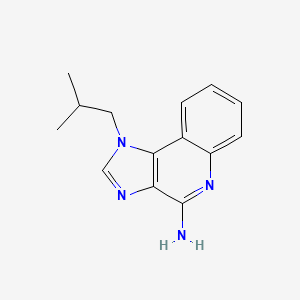
![manganese(2+);(4R,9R,14R,19R)-3,10,13,20,26-pentazatetracyclo[20.3.1.04,9.014,19]hexacosa-1(26),22,24-triene;dichloride](/img/structure/B1671796.png)
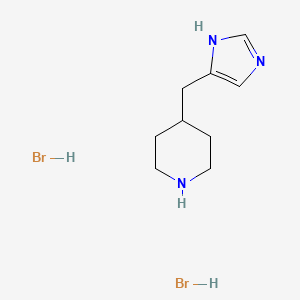

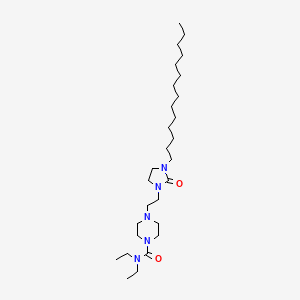
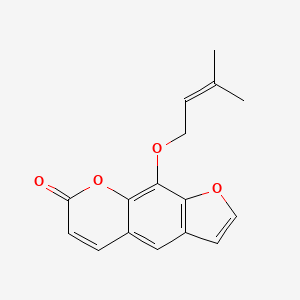

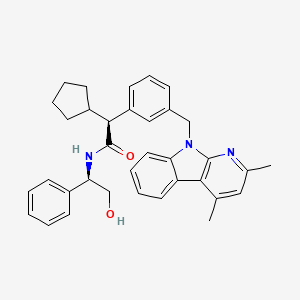
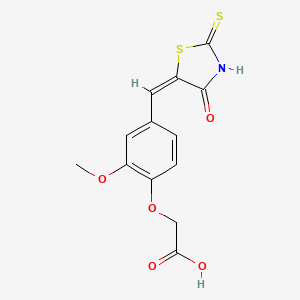
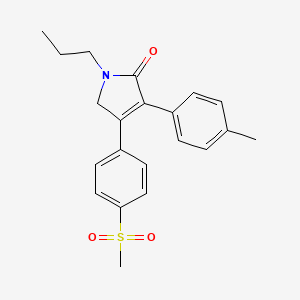
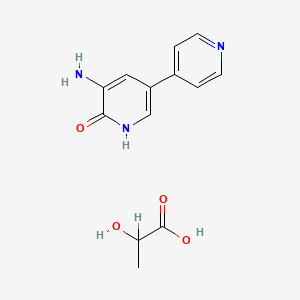
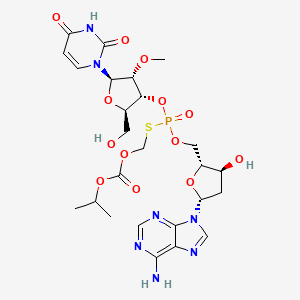
![9,10-Dihydro-9,10[1',2']-benzenoanthracene-1,4-dione](/img/structure/B1671815.png)

